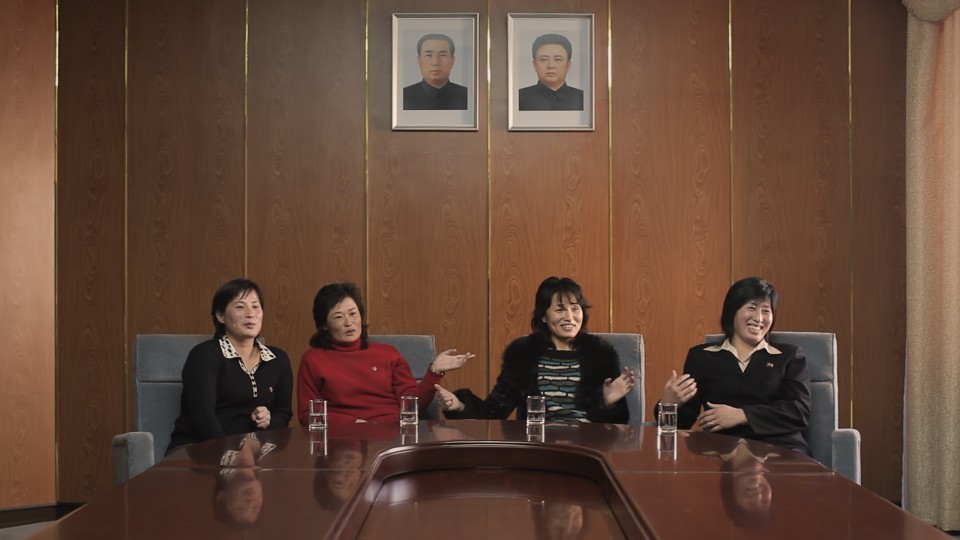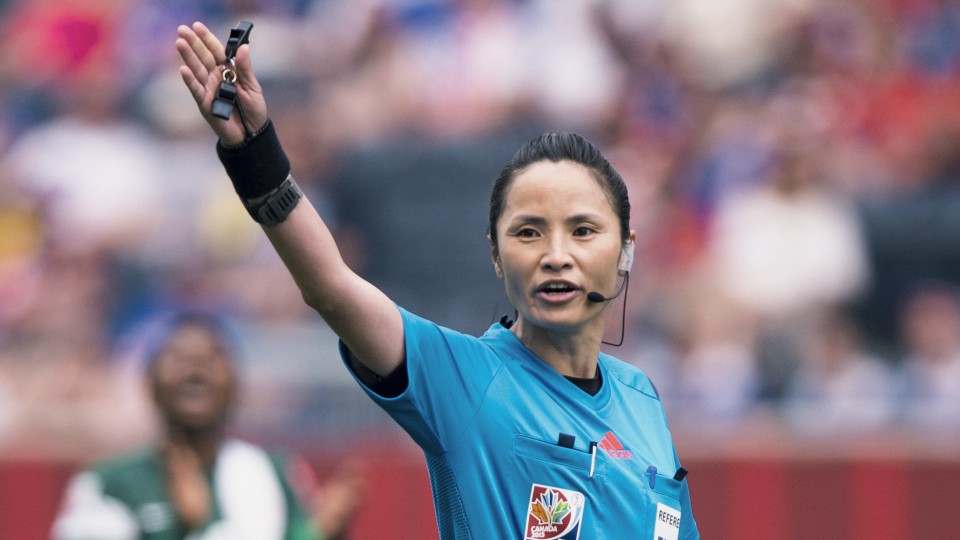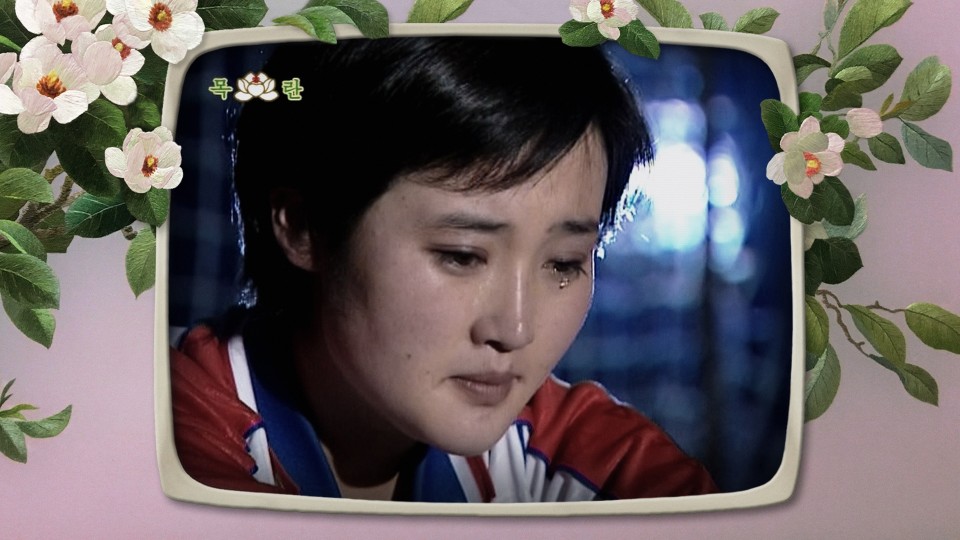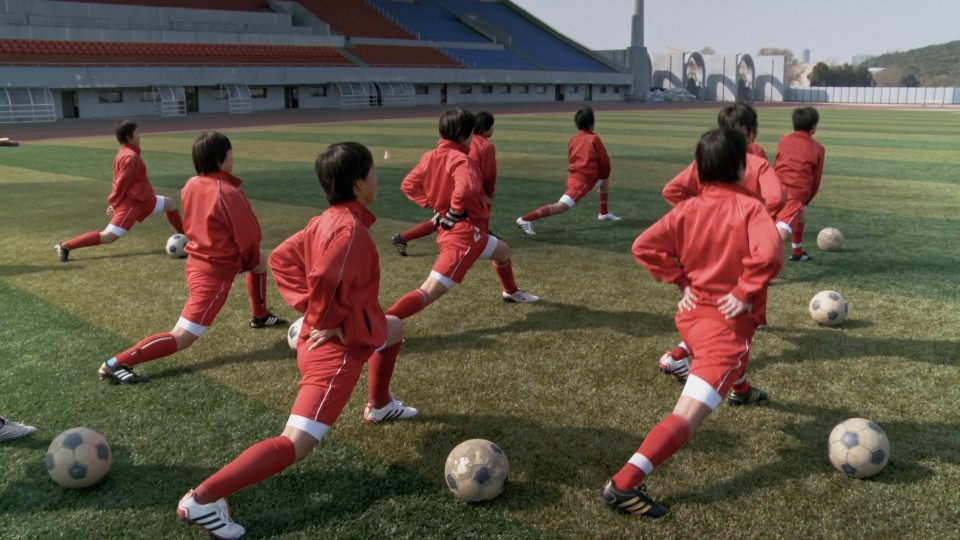Following her portrait of the North Korean women's football dream team in the early 2000s (Hana, dul, sed... 2009), filmmaker Brigitte Weich and her cinematographer Judith Benedikt felt the urge to find out how the lives of their
extraordinary protagonists continued after the end of their active sports careers. Defying the impenetrable wall imposed by
the dictatorship, ... NED, TASSOT, YOSSOT ... manages fleetingly to overcome the isolation in a tireless, multi-layered attempt to connect.
We're not just talking about a film, we're talking about its twenty-year history, which is an inseparable part of it. The
successes of North Korean women's football in the early 2000s were only one element in your two films Hana, dul, sed ... (2009) and now ... NED, TASSOT, YOSSOT... How did this artistically and humanly far-reaching encounter come about?
BRIGITTE WEICH: It all happened by chance. Chance. Chance. I had never planned to make a film, I had no idea about North Korea, I didn't know
that women's football existed as a sport. My first encounter with North Korea was at the 2002 Pyongyang Film Festival. I just
wanted to take a look at the country, and the opportunity arose when Michael Glawogger's film France, Here We Come! was shown there. Football was a popular topic, and the talk turned to the fact that the North Korean women’s team had just
become Asian champions. As I was leaving, I said casually: A film should be made about them. Back in Vienna, a few days later,
I got a fax asking how our project on women's football was going. It came from Ryom Mi Hwa, an employee of the state company
Korfilm, who had taken my remark seriously. She saw the whole thing through with us, right from the start. At first, I tried
to find possible directors and companies, and ... well (laughs) ... twenty years later, I guess that's still me.
Judith Benedikt, how did you grow into this project as DoP?
JUDITH BENEDIKT: I've been involved since the first footage shot at the 2003 Asian Cup in Bangkok. Brigitte and I met there. Ever since that
first trip to Bangkok, I’ve been keen on the project, and we started to establish contact with the protagonists. The presence
of the camera was very unusual for them. We got closer by taking small steps, and at some point we were allowed to get on
their team bus. I also gave them the camera and let them film themselves. Since we couldn't communicate linguistically, we
built up closeness through filming.
How did the idea for a second film develop from the afterlife of the first film?
JUDITH BENEDIKT:We talked several times about the idea of a long-term documentary. And then, on the spur of the moment, we used the prize
money from the Grand Diagonale Prize for another trip to North Korea, to show the film to the protagonists and to film bonus material for the DVD of Hana, dul, sed...
We had seven days of shooting, and since we didn’t know whether we’d be able to shoot there again anytime soon, we used that
time to capture the footage for ... NED, TASSOT, YOSSOT ... One new aspect was that our protagonists were very keen to tell
their stories on camera. In the first movie it was so hard to get them to talk, but this time it just came bubbling out of
them. They were probably also inspired by the showing of the first film, which they really liked. Our first film had a rather
static camera, so for ... NED, TASSOT, YOSSOT ... part of our concept was to react more flexibly and spontaneously, to convey
a feel for life there as well. The GoPro, which I attached to the front of our film bus every day, also shows in uncensored
form what we saw when we drove through Pyongyang. The filming in 2012 was the only real shooting period. In 2016 we were at
the film festival, and then I filmed a few "city trips" unofficially with my iPhone.
What freedoms and opportunities do you have if you want to shoot exterior footage in Pyongyang?
JUDITH BENEDIKT: For the first film, there were very restrictive conditions: depictions of the leader always had to be symmetrical and frontal,
no wires were allowed to run through the face on the leader’s pictures, the slogans you see everywhere in the city couldn’t
be cut. During one shoot, we even had a cameraman with us who wanted to check every frame. For ... NED, TASSOT, YOSSOT ...
everything was more relaxed; at first, for example, no one objected to the GoPro. Although at some point they did ban it.
In the evening, we had to take the material to the censor. In 2012 it wasn't like Hana, dul, sed ..., where there was a room in the hotel with men sitting there in their undershirts, smoking, and where I always had to leave
the whole camera, because we didn't have a standard cassette format. That was tense, because we were handing over the original.
In 2012 we already had memory cards and I was able to take a hard drive to the censor without any material I thought might
be a problem. A little pre-censorship censorship, so to speak. It was already clear to us then that we would show pictures
of Pyongyang nobody in the world had ever seen.
BRIGITTE WEICH: The interesting thing was that they never took anything away from us, they just said what they didn't want. A "quaint" kind
of censorship. Nevertheless, it wasn’t possible to ignore their objections, if only out of a sense of responsibility to the
North Korean contributors.
The film is framed and structured by sequences with children making music or dancing. Was it your aim to shed light on the
topic of education in a totalitarian system: the early integration into the collective, where performance operates on a communal
level and is in the service of the great leader?
BRIGITTE WEICH: That observation is correct. It's one of the areas where I was struck by how differently we are socialized: for example,
sometimes in the final credits it was difficult to name individual contributions. Ryom Mi Hwa, who organized everything for
both films, and Jang Hyang Gi, who spent so many hours translating – these two women, who are so essential to the making of
the films, said repeatedly that their names should not be mentioned. This discrepancy also arose in the narrative of the films;
we were interested in the protagonists as individuals, while it seemed almost frowned upon for them to talk about themselves.
The country, the people, the leader come first. A culture clash. But over time, that has changed. We have "culturally rubbed
off on each other".
The success of the players led to the production of a TV series about them, excerpts from which create an interesting clash
between fantasy and the reality of competitive sports. How did the series slip into the film, in formal terms?
BRIGITTE WEICH: The series originated at about the same time as Hana, dul, sed... . It is also interesting that Ms. Cha Suk, North Korea's only female director, directed the film. It's a melodramatic miniseries
which provides an insight into everyday life in North Korea the like of which we have never seen before. It was fascinating
to juxtapose these staged people with the real ones. It reminded me of the time when I first went to North Korea: I met these
"stereotypical" people who either constantly said something unctuous about the leaders or turned away in fright. I couldn't
imagine that our footballers would be such "templates" at home. The series raises an interesting issue about the contrasts
between the image someone else has of you and the image you have of yourself. For me, it was about getting a core that fits
in the sense that all sides feel represented. The series certainly also prompted self-reflection on the part of the players:
Who am I? How do I want to appear? How am I portrayed? How am I perceived? What might I be used for?
What issues arose during the editing?
BRIGITTE WEICH: The editing caused us quite a headache. In addition to the various thematic strands – old film/new film/TV series/long-term
observation/making of ... – the material of our shoot became "historical" over time, because the financing took so long. I
had two editors who did a great job of bringing the material together: Mona Willi, who already had so much experience with
a wide variety of directors, and Barbara Seidler, who was fresh out of film academy. A great mix. The epilogue was based on
an idea of Mona's. When we were suddenly in lockdown, everything felt so "North Korean": her first idea was to record a Zoom
meeting with the protagonists. But the people there don't have the Internet in their private lives. However, that did provide
ideas about using current images for an epilogue. Unfortunately, the first attempt to film footage in line with our requirements
via Korfilm didn’t work out. Ryom Mi Hwa then apparently succeeded in persuading North Korean television to make a small documentary
featuring our protagonists. Just when I’d given up believing it would happen, a link to a documentary appeared, plastered
with propaganda music and a speaker's voice – completely useless. But within a few hours, Barbara sent me the first draft
of the epilogue. In the end we got the clean raw material, and Barbara worked with everything that was at all usable.
... NED, TASSOT, YOSSOT ... has also become a touching record about the way time passes, like a large chunk of life.
BRIGITTE WEICH: Judith and I always had the idea of filming them after the regime had collapsed. I didn’t think it would survive Kim Jong
Il's death, because the charisma of the founder of the state, Kim Il Sung, would not be enough for another generational change
in this globalized world. Now I’m starting to think maybe that regime will outlive me. Then Judith will have to travel to
North Korea by herself, as an old lady. Personally, I like long-term documentaries very much, and I find it exciting to see
how societies change and how individuals have to cope with regimes and developments. Through the most varied (im)possibilities,
our film has become a collection of images that I could not have planned in this way. Thanks to Judith's magic hand and that
of our grader Simon Graf, with all the sharpening, stabilizing and color correcting in post-production, the images also hold
up on the big screen and now cover this long period of time. I wouldn't have been able to stick with it for so long if I hadn't
had this company in crime. The images and sounds only exist thanks to the great skill and hard work of Judith and Cordula
Thym. In addition, there was this strange, strong emotion that mobilized us again and again. As the North Koreans say: Over the mountains, there are mountains – it was by following this principle that we worked on towards the finished film.
Interview: Karin Schiefer
October 2023
Translation: Charles Osborne






